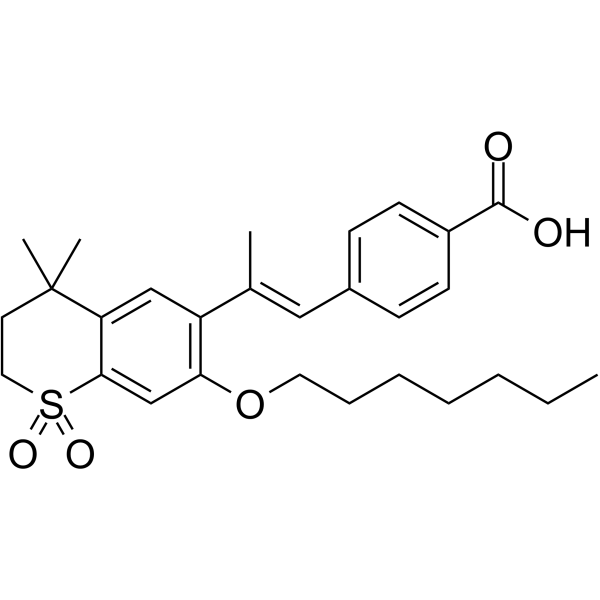Ro 41-5253

Ro 41-5253 structure
|
Common Name | Ro 41-5253 | ||
|---|---|---|---|---|
| CAS Number | 144092-31-9 | Molecular Weight | 484.64700 | |
| Density | 1.154g/cm3 | Boiling Point | 661.4ºC at 760 mmHg | |
| Molecular Formula | C28H36O5S | Melting Point | N/A | |
| MSDS | Chinese USA | Flash Point | 353.8ºC | |
Use of Ro 41-5253Ro 41-5253 is an orally active selective retinoic acid receptor alpha (RARα) antagonist. Ro 41-5253 can bind RARα without inducing transcription or affecting RAR/RXR heterodimerization and DNA binding. Ro 41-5253 can inhibit cancer cell proliferation and induce apoptosis, has antitumor activity[1][2]. |
| Name | 4-[(E)-2-(7-heptoxy-4,4-dimethyl-1,1-dioxo-2,3-dihydrothiochromen-6-yl)prop-1-enyl]benzoic acid |
|---|---|
| Synonym | More Synonyms |
| Description | Ro 41-5253 is an orally active selective retinoic acid receptor alpha (RARα) antagonist. Ro 41-5253 can bind RARα without inducing transcription or affecting RAR/RXR heterodimerization and DNA binding. Ro 41-5253 can inhibit cancer cell proliferation and induce apoptosis, has antitumor activity[1][2]. |
|---|---|
| Related Catalog | |
| Target |
IC50: 60 nM (RARα), 2.4 μM (RARβ), 3.3 μM (RARγ)[3]. |
| In Vitro | Ro 41-5253 (1 nM-10 μM, 10 days) significantly inhibits MCF-7 and ZR 75.1 cell proliferation and induces cell apoptosis in a time and dose-dependent manner[1]. Cell Proliferation Assay[1] Cell Line: Human breast-carcinoma lines MCF-7 and ZR 75.1 Concentration: 1 nM-10 μM Incubation Time: 10 days Result: Inhibited 81% MCF-7 cell growth at 10 μM, 30% cell growth at 1 μM and no significant inhibitory effect at concentrations below 0.1 μM. Inhibited 74% ZR 75.1 cell growth at 10 μM, 63% cell growth at 1 μM and 42% cell growth at 0.1 μM. Apoptosis Analysis[1] Cell Line: Human breast-carcinoma lines MCF-7 and ZR 75.1 Concentration: 1 nM-10 μM Incubation Time: 10 days Result: Induced 28.5, 21.6, 16 and 12% of MCF-7 cells apoptosis at 10 μM, 1 μM, 0.1 μM and 0.01 μM respectively on the fourth day while induced 58, 51, 36 and 21% of cells apoptosis at 10 μM, 1 μM, 0.1 μM and 0.01 μM respectively after six days. Induced 80, 65, 43 and 29% of ZR 75.1 cells apoptosis at 10 μM, 1 μM, 0.1 μM and 0.01 μM respectively on the sixth day. |
| In Vivo | Ro 41-5253 (oral gavage, 10-600 mg/kg, once a week, 4 weeks) can reduce tumor volume in female athymic Balb/mice transplanted with MCF-7 cell line[2]. Animal Model: Six-week-old female athymic Balb/mice transplanted with MCF-7 cell line[2] Dosage: 10, 30, 100, 300 and 600 mg/kg Administration: Oral gavage; once a week; 4 weeks Result: Resulted in a reduction in tumor volume at doses of 10, 30 and 100 mg/kg with no toxic side effects. |
| References |
| Density | 1.154g/cm3 |
|---|---|
| Boiling Point | 661.4ºC at 760 mmHg |
| Molecular Formula | C28H36O5S |
| Molecular Weight | 484.64700 |
| Flash Point | 353.8ºC |
| Exact Mass | 484.22800 |
| PSA | 89.05000 |
| LogP | 7.83030 |
| Vapour Pressure | 2.16E-18mmHg at 25°C |
| Index of Refraction | 1.558 |
| RIDADR | NONH for all modes of transport |
|---|
|
Effect of all-trans-retinoic acid on enterovirus 71 infection in vitro.
Br. J. Nutr. 111(9) , 1586-93, (2014) Our previous studies have shown that vitamin A (VA) status is associated with antiviral immunity and pathogenic conditions in enterovirus 71 (EV71)-infected children. In the present study, we establis... |
|
|
Retinoic acid inhibits in vivo interleukin-2 gene expression and T-cell activation in mice.
Immunology 126(4) , 514-22, (2009) Interleukin-2 (IL-2) is an essential cytokine for T-lymphocyte homeostasis. We have previously reported that all-trans retinoic acid (atRA) enhances the secretion of IL-2 from human peripheral blood T... |
|
|
Overexpression of mucin genes induced by interleukin-1 beta, tumor necrosis factor-alpha, lipopolysaccharide, and neutrophil elastase is inhibited by a retinoic acid receptor alpha antagonist.
Exp. Lung Res. 28(4) , 315-32, (2002) Proinflammatory cytokines, lipopolysaccharide (LPS), and neutrophil elastase (NE) have been implicated in the induction of hypersecretion of respiratory mucus. In this study, we demonstrated that inte... |
| LG-629 |
| Ro 41-5253 |